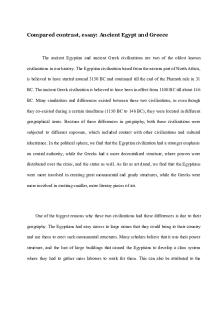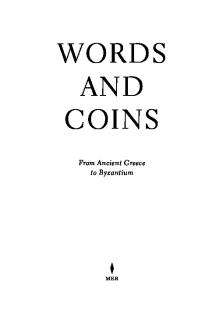Chapter 5 Ancient Greece High classical PDF

| Title | Chapter 5 Ancient Greece High classical |
|---|---|
| Author | Daniel Carpenter |
| Course | Survey Of Art History I |
| Institution | University of Nevada, Las Vegas |
| Pages | 7 |
| File Size | 728.6 KB |
| File Type | |
| Total Downloads | 100 |
| Total Views | 162 |
Summary
Professor: Patricia Bailey
Notes on Chapter 5: Ancient Greece, specifically the High Classical art period....
Description
CHAPTER 5 | ANCIENT GREECE High Classical 450-400 BCE
POLYKLEITOS. Doryphoros (Spear Bearer) or Canon of Polykleitos c. 450-440 BCE fig. 5-41 - A moment of reserve. Tension of the energy yet to be dispensed - Classical sculpture’s supreme example - Perfection that Greeks strived for - Tree stump gives away Grecco-Roman copy - Chiastic style - S curve - Golden mean; applied to figures and architecture
Aerial view of the Acropolis fig. 5-43 - Chose locations of buildings based on the sanctity of the buildings - Never finished - Parthenon, , temple of Athena - Largest 100% marble building in the world
IKTINOS AND KALLIKRATES. Parthenon 447-439 BCE fig. 5-1 1. Project was led by iktinos 2. Ratio of proportions was specific 3. Doric with ionic elements 4. Destroyed in battle with rock when used as ammory by Turks 5. Might be a blend of ionic and doric to pay homage to all greek cultures 6. Stacked columsn (made of drums) ● Golden Section or Mean | X = 2Y + 1 ● 17 on long sides, 8 on short sides. 17 = (2x8) + 1 ● Harmonious proportions result in visual beauty
PHIDIAS. Athena Parthenos (model) c. 438 BCE fig. 5-46 - Narrative display of procession in temple - First time temple in greece depicts a human event in temples - Main attraction | shrine - Gold and ivory | crystellaphantine | 38 ft. in height - - wooden core, bronze plates, gold plates - Presenting a winged victory; achieving conquering of the Persians; order over chaos - Humans vs. Amazons | Humans vs. Giants - replica in Toronto and Tennesee
Three Goddesses from the Parthenon c. 438-432 BCE fig. 5-49 - East pediment - Birth of Athena by Zues' headache - Placed her standing by her father and Hestia, Deroni, Aphrodite - Thettian style, drapery is clingy - Completely in the round
Caryatids of the Erechtheion c. 421-405 BCE fig. 5-54 - Features the porch of the maidens. - Found on the acropolis, executed in ionic style - Accommodated 4 different sacred events without altering , corporate preexisting shrines, and a duel. - 2nd largest building, on uneven terrain - 6 charicatics in contraposta. Wide body to bear weight.
KALLIKRATES. Temple of Athena Nike c. 427-424 BCE fig. 5-55 - Ionic order jewel - Nonperipteral. - Amfrostyle, 2 porched short ends and no peristyle. Simple and graceful. - Capitals show it's iconic - Frieze shows persians defeated at battle of merithon. - Peripet shows reliefs of Nike.
Nike adjusting her sandal c. 410 BCE fig. 5-56 - Part of it actually fully in round. Naturalistic. - Thettian style of drapery. Sensuous. Detailed folds create an active surface that distracts from awkward pose and gives her dignity.
High Classical White-ground Painting
PHIALE PAINTER. Hermes bringing the infant Dionysos to Papposilenos c. 440-435 BCE Fig. 5-60 -
Almost all surviving paintings are left on all on vases because mirror and panel mural painting is often lost. Mimicked colors of panel painters Interred with the dead as offerings due to fragility of paint. Intense emotional/inner psychological feelings in subjects repressed - reserved visually Used white slip for the details and specific paints that would survive firing to mimick real value contrasts. Ivory background - clay. Special white engine used for women’s skin. Understanding of contrapposto displayed in vase and shows movement through space. Increases naturalism. Hermes’ demeanor is kept in check; shows that this is high classical; inner state captured in the pose...
Similar Free PDFs
Popular Institutions
- Tinajero National High School - Annex
- Politeknik Caltex Riau
- Yokohama City University
- SGT University
- University of Al-Qadisiyah
- Divine Word College of Vigan
- Techniek College Rotterdam
- Universidade de Santiago
- Universiti Teknologi MARA Cawangan Johor Kampus Pasir Gudang
- Poltekkes Kemenkes Yogyakarta
- Baguio City National High School
- Colegio san marcos
- preparatoria uno
- Centro de Bachillerato Tecnológico Industrial y de Servicios No. 107
- Dalian Maritime University
- Quang Trung Secondary School
- Colegio Tecnológico en Informática
- Corporación Regional de Educación Superior
- Grupo CEDVA
- Dar Al Uloom University
- Centro de Estudios Preuniversitarios de la Universidad Nacional de Ingeniería
- 上智大学
- Aakash International School, Nuna Majara
- San Felipe Neri Catholic School
- Kang Chiao International School - New Taipei City
- Misamis Occidental National High School
- Institución Educativa Escuela Normal Juan Ladrilleros
- Kolehiyo ng Pantukan
- Batanes State College
- Instituto Continental
- Sekolah Menengah Kejuruan Kesehatan Kaltara (Tarakan)
- Colegio de La Inmaculada Concepcion - Cebu















